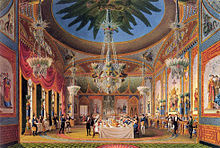Londonderry House
Londonderry House was a mansion on Park Lane in Mayfair in the British capital, London . The house was the home of the Irish aristocratic Stewart family , the Marquesses of Londonderry . It remained her London city residence until it was demolished in 1965.
Surname
In 1819 Charles Vane, 1st Baron Stewart , a British aristocrat, bought Londonderry House as home for his family for the time they were in London. Lord Stewart was promoted to 3rd Marquess of Londonderry in 1822 . Even though the house had been in the hands of the Vane family for over 150 years, it had a story before that.
history
It was bought by the 6th Earl of Holdernesse in the 1760s , as was the neighboring house, which he later bought. He then had both houses connected to form a London townhouse with two front facades.
In 1819 Lord Stewart bought the huge house. The family also owned Wynyard House in County Durham and Mount Stewart in Ulster in Ireland. Soon after, the Marquess of Londonderry began the renovation. He spared no expense, as you can see from the choice of his architects: Benjamin Dean Wyatt and Philip Wyatt .
In 1835 the major renovation was completed and the new house left Londoners shivering in awe. The grand staircase was supposed to outstrip that of nearby Lancaster House , and he succeeded: it had a large skylight, Rococo chandeliers, and two separate flights of stairs side by side. This grand staircase led to the Grand Ballroom, which was decorated with pictures of male members of the Stewart family in parade attire. It is said that this room was inspired by the Waterloo Chamber at Apsley House , but it surpassed this too. Large marble statues by Antonio Canova and French- style chairs were arranged around the room .
From there you came into the dining room, which displayed the wonderful collection of silver that the Londonderrys had known as the Londonderry Silver . The City of Brighton bought a large part of it for the Royal Pavilion , where it can now be admired along with the Ormonde Silver .
Another elegant room was the three-part salon, which was decorated with other pieces of silver, French furniture and paintings by international artists. The ceiling was painted with birds.
During the First World War the house served as a military hospital. After the war, Charles Vane-Tempest-Stewart, Viscount Castlereagh , and his wife Edith Helen Chaplin continued to use the house and held many parties and receptions there. After World War II , the house remained in the possession of the Londonderry family.
The Londonderry era was over by the end of the 1950s because it was too expensive to be in such a large house.
It was sold and demolished in 1962. The London Hilton was built in its place .
Individual evidence
- ^ Anita Singh: Sale of the century as aristocrats auction heirlooms . Daily Telegraph. March 30, 2014. Retrieved September 18, 2015.
literature
- Anne de Courcy: Society's Queen: The Life of Edith, Marchioness of Londonderry . Phoenix, London 2004. ISBN 0-7538-1730-6 (Original edition by Circe: The Life of Edith, Marchioness of Londonderry . London: Sinclair-Stevenson, 1992. ISBN 1-85619-363-2 )
- Christopher Simon Sykes: Private Palaces: Life in the Great London Houses . Viking Penguin, New York 1986. ISBN 0-670-80964-0 .
Coordinates: 51 ° 30 ′ 20 ″ N , 0 ° 9 ′ 1 ″ W.

